Asia-Pacific Oilfield Chemicals Market Size
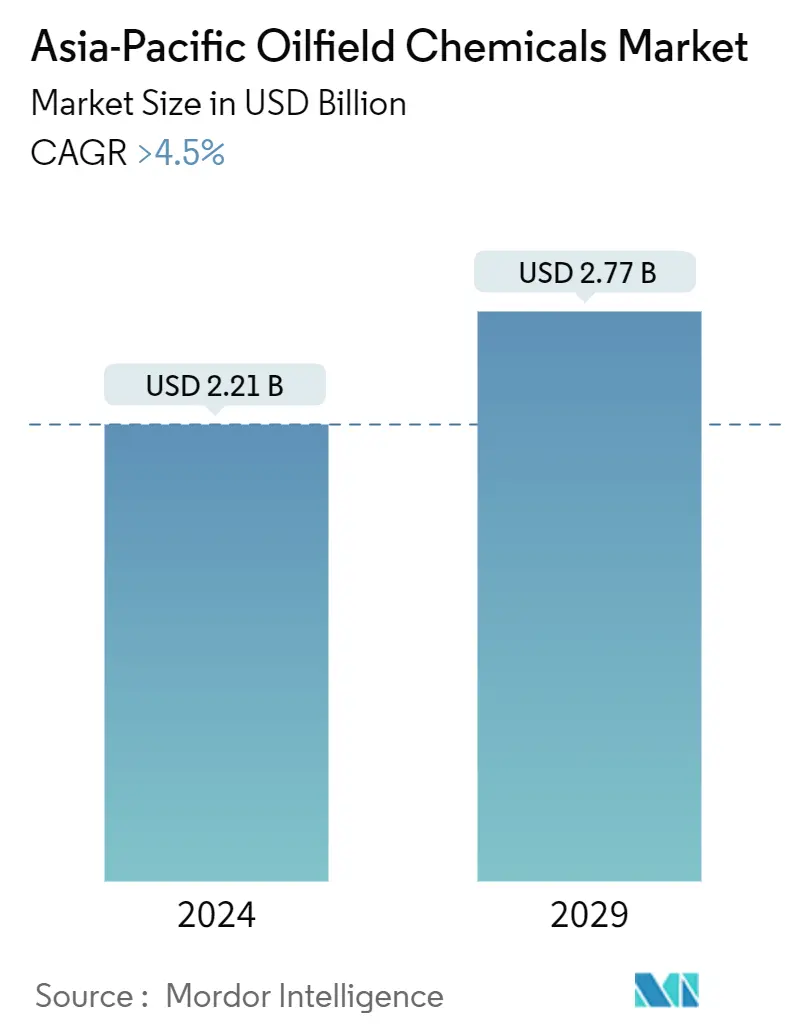
| Study Period | 2019 - 2029 |
| Base Year For Estimation | 2023 |
| Market Size (2024) | USD 2.21 Billion |
| Market Size (2029) | USD 2.77 Billion |
| CAGR (2024 - 2029) | > 4.50 % |
| Market Concentration | High |
Major Players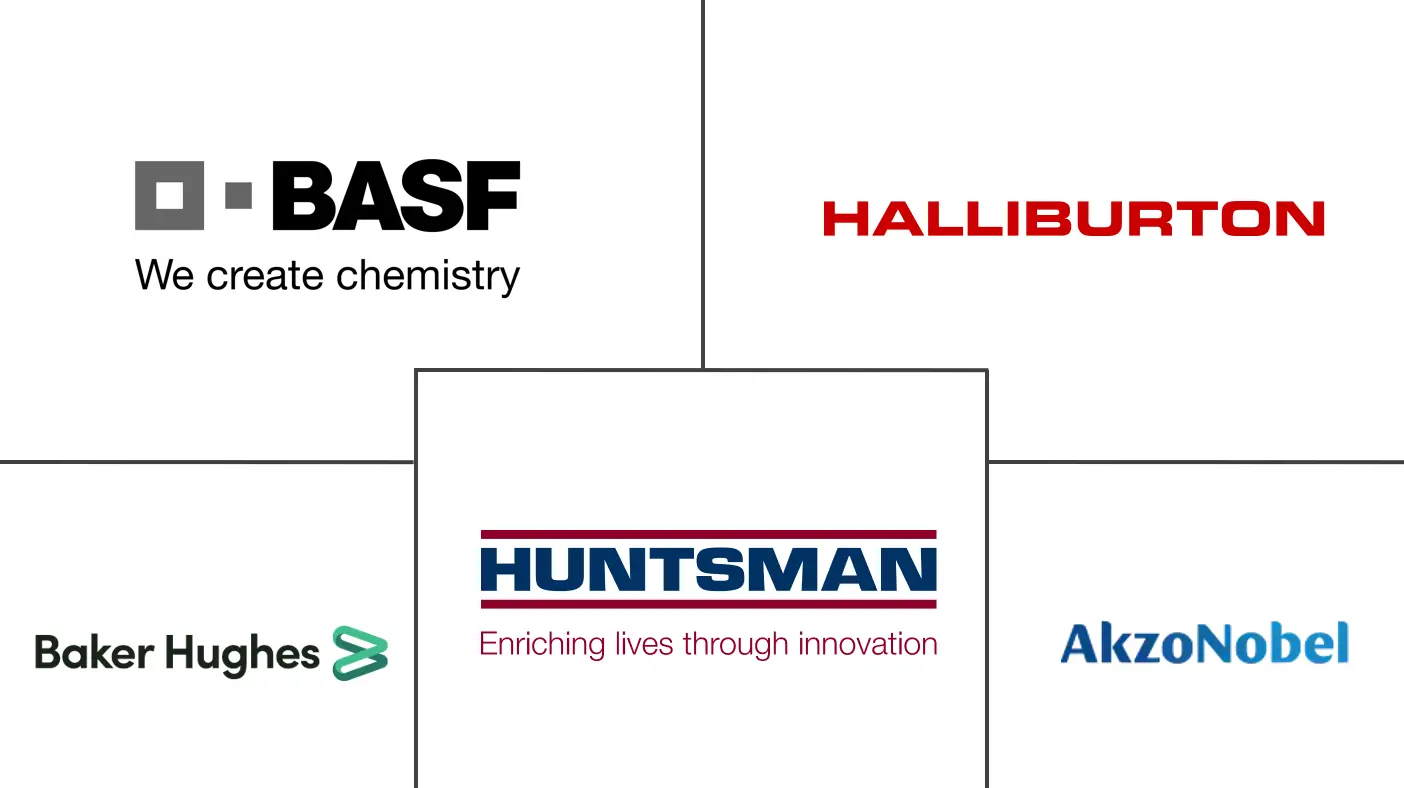
*Disclaimer: Major Players sorted in no particular order |
Need a report that reflects how COVID-19 has impacted this market and its growth?
Asia-Pacific Oilfield Chemicals Market Analysis
The Asia-Pacific Oilfield Chemicals Market size is estimated at USD 2.21 billion in 2024, and is expected to reach USD 2.77 billion by 2029, growing at a CAGR of greater than 4.5% during the forecast period (2024-2029).
The COVID-19 pandemic negatively affected the oil and gas industry, which in turn affected the oilfield chemicals market in the Asia-Pacific region. However, post-COVID-19, the rising demand from the oil and gas industry is expected to revive the market for oilfield chemicals in the region.
- One of the major factors driving the market's growth is the increased share of gas exploration and production in the Asia-Pacific region. Rising demand for petroleum-based fuel from the transportation industry is expected to drive the market demand during the forecast period.
- The rising biofuel industry is likely to hinder the market growth. With the increasing focus on sustainability and environmental concerns, the oilfield chemicals industry may face regulatory pressures and a decline in investor interest as well.
- The increasing focus on deepwater and unconventional resources like shale oil and gas opens up new markets for drilling fluids, lubricants, and completion fluids. Developing high-performance, environmentally friendly chemicals for these challenging environments is a lucrative opportunity.
- China dominated the market across the Asia-Pacific Region, with the most significant consumption of oilfield chemicals in this region.
Asia-Pacific Oilfield Chemicals Market Trends
Corrosion and Scale Inhibitors segment to dominate the market
- Corrosion inhibitors are used to reduce corrosion in the metallic pipes of the oil well. Inhibition is the preferred treatment for carbon steel pipes and vessels. The advantage of inhibition is that it can be used in most cases even when the process is continuing.
- Corrosion occurs due to the reaction of oxygen with metallic parts to form oxides. Corrosion inhibitors act by forming a thin barrier layer over the exposed parts. Several types of corrosion inhibitors are used in oilfields.
- These include Deha - Diethyl Hydroxyl Amine, Polyamine, Morpholine, Cyclohexylamine, and Carbon Dioxide Corrosion Inhibitors. A mixture of filming amines is used to prepare condensate line corrosion inhibitors. This can protect every stage due to the presence of both high and low vapor/liquids.
- Scale is a residue that forms on the surface of oilfield equipment as a result of the precipitation of soluble solids that become insoluble as temperature increases. This, in turn, causes metallic corrosion that affects the functioning and maintenance of equipment. This deposition increases corrosion rates, causes loss of production, and restricts flow.
- Hence, to safeguard oilfield equipment and to maintain their efficiency, it is necessary to maintain accurate conditions by adding scientifically designed chemicals that act as scale inhibitors. Chemicals, such as organic phosphates, inorganic phosphates, polymers (polyacrylates), phosphonates, and ethylenediaminetetraacetic acid (EDTA), an organic chelating agent, are some of the scaling inhibitors. Corrosion inhibitors are used to reduce corrosion in metallic pipes of oil wells. Inhibition is the preferred treatment for carbon steel pipes and vessels.
- As per Rystad, offshore projects will drive the recovery in greenfield investment, with significant demand for subsea infrastructure and drilling services in the oil and gas industry.
- For example, Petronas's Kasawari announced investment approval for the first carbon capture and storage (CCS) in Malaysia, which was followed by Thai company PTT Exploration and Productions's (PTTEP's) Lang Lebah, targeting FID in 2023 in Malaysia.
- Shell's recent investment approval for the Gumusut-Kakap-Geronggong-Jagus East (GKGJE) deep-water project – a subsea tieback development planned to start up in 2024, according to the Energy Industries Council.
- As per S&P Global Inc., New Zealand's Refining NZ said it was working to finalize terminal services agreements with customers in October to enable the conversion of its Marsden Point refinery into an import terminal in the first half of 2022.
- As per S&P Global Inc, Australia's Viva Energy welcomed the federal government's announcement of a fuel security package and, as part of this, would make a six-year commitment to maintain refining operations at Geelong through to June 2027 with a further three-year option to extend until June 2030.
- A USD 4 billion clean fuel project is being undertaken at Thailand's Sriracha refinery. The upgrade is slated to be completed in 2023 and will increase the refinery's capacity from 275,000 b/d to 400,000 b/d, boosting the yield of cleaner products. as per S&P Global Inc.
- Furthermore, new contracts for maintenance in Asia-Pacific exhibit increased investment in corrosion and scale inhibitors during the forecast period.
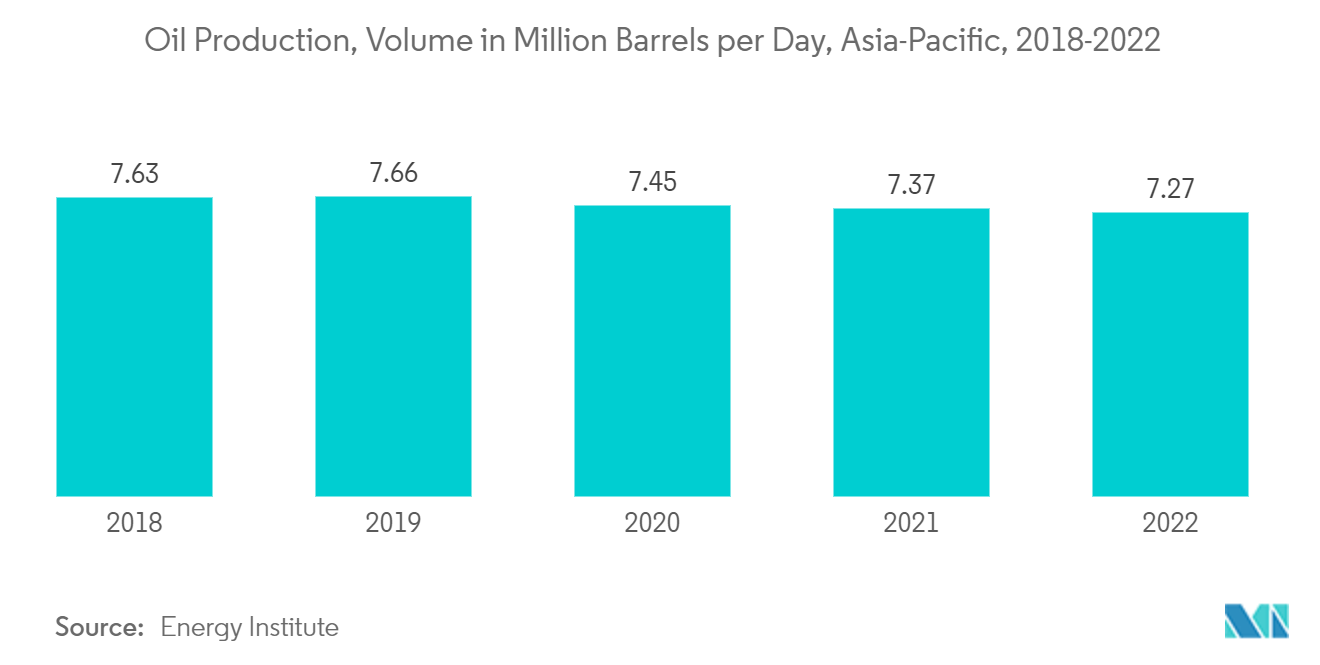
China to Dominate the Market
- The oil and gas industry is one of the key contributors to the Chinese economy. The oil and gas industry operates in high-temperature environments.
- Oilfield chemicals are used in drilling, production, stimulation, and enhanced oil recovery activities. Developing oil and gas reserves from shale formations requires activities such as hydraulic drilling, which encourages the use of oilfield chemicals. China has achieved many milestones in capacity and drilling techniques in shale gas exploration. This makes it one of the top shale gas suppliers around the globe.
- According to BP Statistical Review 2023, the overall oil production in the country reached 204.7 million metric tons in 2022 at a growth rate of 2.9% compared to 198.9 million metric tons produced in 2021.
- Similarly, the country's overall oil consumption has been on the rise over the past decade. For instance, in 2022, the country's oil consumption in thousands of barrels per day was 14,295 thousand barrels per day, whereas in 2021, the consumption stood at 14,893 thousand barrels per day. In addition, the consumption growth rate has been 3.6% yearly over the decade between 2012 and 22.
- Moreover, the same source cited that the country witnessed positive growth in natural gas production. For instance, in 2021, the natural gas produced was 209.2 billion cubic meters, whereas in 2022, the production increased to 221.8 billion cubic meters, which is around 6.0% growth. In addition, over the decade, production has been growing by an average of 7.1% yearly.
- The increase in the production capacities of oil and gas in the country is likely to drive the market for oilfield chemicals in the country.
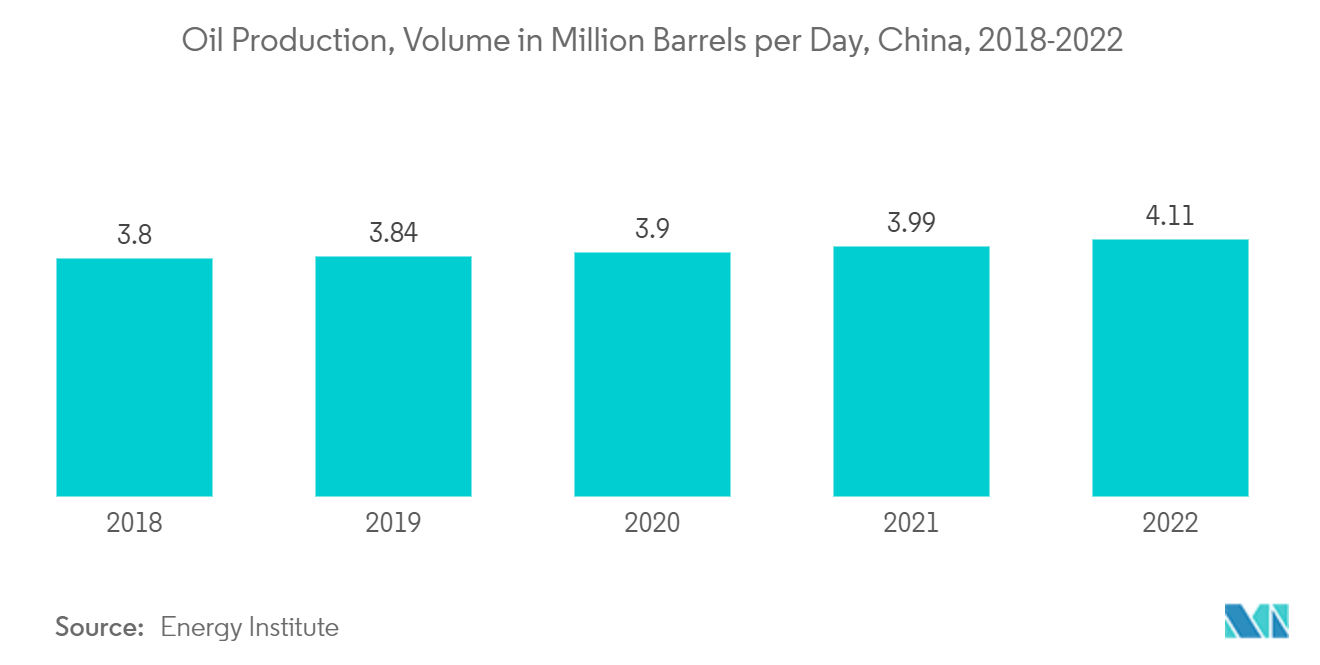
Asia-Pacific Oilfield Chemicals Industry Overview
The Asia-Pacific oilfield chemicals market is partially consolidated in nature. The major players (not in a particular order) include AkzoNobel N.V., Haliburton, Huntsman International LLC, Baker Hughes Company, and BASF SE, among others.
Asia-Pacific Oilfield Chemicals Market Leaders
AkzoNobel N.V.
BASF SE
Haliburton
Huntsman International LLC
Baker Hughes Company
*Disclaimer: Major Players sorted in no particular order
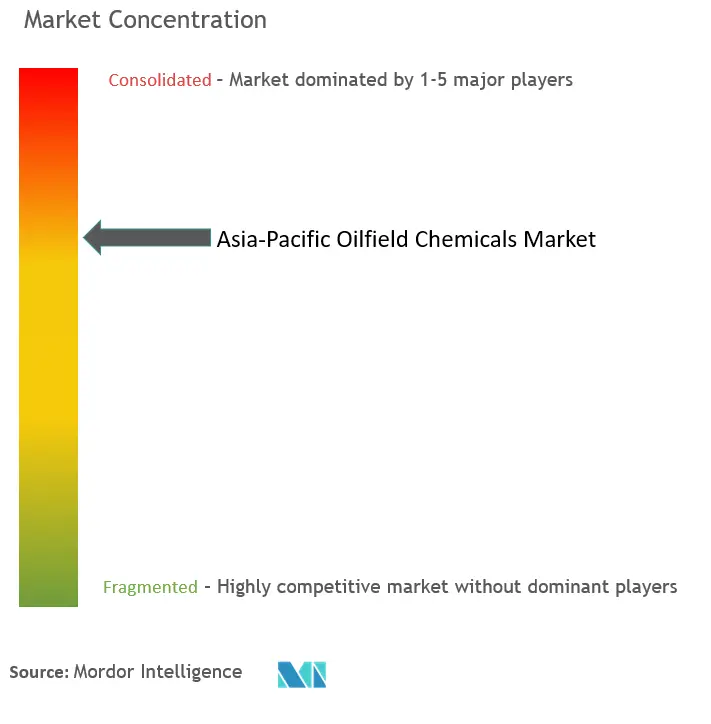
Asia-Pacific Oilfield Chemicals Market News
Aug 2022: Baker Hughes announced the construction of a new oilfield services chemicals manufacturing facility in Singapore, enabling manufacturing optimization and faster delivery of fit-for-purpose chemical solutions. The facility will manufacture, store, and distribute chemical solutions for upstream, midstream, downstream, and adjacent industries. It will further help the company expand its operations in Asia.
APAC Oilfield Chemicals Market Report - Table of Contents
1. INTRODUCTION
1.1 Study Deliverables
1.2 Study Assumptions
1.3 Scope of the Study
2. RESEARCH METHODOLOGY
3. EXECUTIVE SUMMARY
4. MARKET DYNAMICS
4.1 Drivers
4.1.1 Rising Demand for Petroleum-based Fuel from the Transportation Industry
4.1.2 Increased Shale Gas Exploration and Production in Asia-Pacific
4.1.3 Other Drivers
4.2 Restraints
4.2.1 Rising Biofuel Industry
4.2.2 Clean Energy Initiatives
4.3 Industry Value Chain Analysis
4.4 Porter's Five Forces Analysis
4.4.1 Bargaining Power of Suppliers
4.4.2 Bargaining Power of Buyers
4.4.3 Threat of New Entrants
4.4.4 Threat of Substitute Products and Services
4.4.5 Degree of Competition
5. MARKET SEGMENTATION (Market Size in Value)
5.1 Chemical Type
5.1.1 Biocide
5.1.2 Corrosion and Scale Inhibitor
5.1.3 Demulsifier
5.1.4 Polymer
5.1.5 Surfactant
5.1.6 Other Chemical Types (Organic Acids, Fracturing Fluids, etc.)
5.2 Application
5.2.1 Drilling and Cementing
5.2.2 Enhanced Oil Recovery
5.2.3 Production
5.2.4 Well Stimulation
5.2.5 Workover and Completion
5.3 Geography
5.3.1 China
5.3.2 India
5.3.3 Japan
5.3.4 South Korea
5.3.5 Malaysia
5.3.6 Thailand
5.3.7 Indonesia
5.3.8 Vietnam
5.3.9 Philippines
5.3.10 Australia & New Zealand
5.3.11 Rest of Asia-pacific
6. COMPETITIVE LANDSCAPE
6.1 Mergers and Acquisitions, Joint Ventures, Collaborations, and Agreements
6.2 Market Share (%)**/Ranking Analysis
6.3 Strategies Adopted by Leading Players
6.4 Company Profiles
6.4.1 AkzoNobel N.V.
6.4.2 Albemarle Corporation
6.4.3 Ashland
6.4.4 Baker Hughes Company
6.4.5 BASF SE
6.4.6 CLARIANT
6.4.7 Chevron Phillips Chemical Company LLC
6.4.8 Dow
6.4.9 Ecolab
6.4.10 Elementis PLC
6.4.11 Haliburton
6.4.12 Huntsman International LLC
6.4.13 Innospec
6.4.14 Kemira
6.4.15 Newpark Resources Inc.
6.4.16 SLB
6.4.17 Solvay
- *List Not Exhaustive
7. MARKET OPPORTUNITIES AND FUTURE TRENDS
7.1 New Horizons Opened Up due to Deep-water Drilling Operations
7.2 Production Opportunities Provided by Developing Countries
Asia-Pacific Oilfield Chemicals Industry Segmentation
Oilfield chemicals are specific chemical compounds used to improve the effectiveness and efficiency of operations associated with an oilfield site. These chemicals are used in applications such as drilling, production, completion, and several other operations under these conditions.
The Asia-Pacific oilfield chemicals market is segmented by chemical type, application, and geography. By chemical type, the market is segmented into biocide, corrosion and scale inhibitor, demulsifier, polymer, surfactants, and other chemicals(organic acids, fracturing fluids, etc.). By application, the market is segmented into drilling and cementing, enhanced oil recovery, production, well stimulation, and workover and completion. The report also covers the market sizes and forecasts for the Asia-Pacific oilfield chemicals market for 10 major countries across the Asia-Pacific region. For each segment, the market sizing has been done on the basis of revenue (USD).
| Chemical Type | |
| Biocide | |
| Corrosion and Scale Inhibitor | |
| Demulsifier | |
| Polymer | |
| Surfactant | |
| Other Chemical Types (Organic Acids, Fracturing Fluids, etc.) |
| Application | |
| Drilling and Cementing | |
| Enhanced Oil Recovery | |
| Production | |
| Well Stimulation | |
| Workover and Completion |
| Geography | |
| China | |
| India | |
| Japan | |
| South Korea | |
| Malaysia | |
| Thailand | |
| Indonesia | |
| Vietnam | |
| Philippines | |
| Australia & New Zealand | |
| Rest of Asia-pacific |
APAC Oilfield Chemicals Market Research FAQs
How big is the Asia-Pacific Oilfield Chemicals Market?
The Asia-Pacific Oilfield Chemicals Market size is expected to reach USD 2.21 billion in 2024 and grow at a CAGR of greater than 4.5% to reach USD 2.77 billion by 2029.
What is the current Asia-Pacific Oilfield Chemicals Market size?
In 2024, the Asia-Pacific Oilfield Chemicals Market size is expected to reach USD 2.21 billion.
Who are the key players in Asia-Pacific Oilfield Chemicals Market?
AkzoNobel N.V., BASF SE, Haliburton, Huntsman International LLC and Baker Hughes Company are the major companies operating in the Asia-Pacific Oilfield Chemicals Market.
What years does this Asia-Pacific Oilfield Chemicals Market cover, and what was the market size in 2023?
In 2023, the Asia-Pacific Oilfield Chemicals Market size was estimated at USD 2.11 billion. The report covers the Asia-Pacific Oilfield Chemicals Market historical market size for years: 2019, 2020, 2021, 2022 and 2023. The report also forecasts the Asia-Pacific Oilfield Chemicals Market size for years: 2024, 2025, 2026, 2027, 2028 and 2029.
Asia-Pacific Oilfield Chemicals Industry Report
Statistics for the 2024 APAC Oilfield Chemicals market share, size and revenue growth rate, created by Mordor Intelligence™ Industry Reports. APAC Oilfield Chemicals analysis includes a market forecast outlook 2029 and historical overview. Get a sample of this industry analysis as a free report PDF download.
